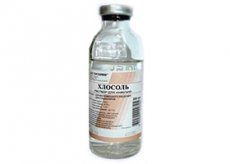Medical expert of the article
New publications
Preparations
Chlossol
Last reviewed: 07.05.2024

All iLive content is medically reviewed or fact checked to ensure as much factual accuracy as possible.
We have strict sourcing guidelines and only link to reputable media sites, academic research institutions and, whenever possible, medically peer reviewed studies. Note that the numbers in parentheses ([1], [2], etc.) are clickable links to these studies.
If you feel that any of our content is inaccurate, out-of-date, or otherwise questionable, please select it and press Ctrl + Enter.

Chlosol - a drug with a combined composition and rehydrating effect on the human body.
Indications of the cholosli
The medication is indicated for use in the case of such pathological conditions:
- Cholera Inaba (El Tor);
- Amoebiasis of acute nature;
- Toxicinfections of food genesis (to reduce or eliminate symptoms of dehydration and poisoning).
 [1]
[1]
Release form
The drug is available in vials with different volumes of fifty, one hundred, two hundred and fifty and five hundred milliliters.
Pharmacodynamics
Due to the combined composition, Chlosol is a saline solution, which is characterized by hemodynamic and de-toxication. That is why it is actively used in inpatient treatment for detoxification and rehydration.
The main effects of the drug are:
- Obstruction of the formation of metabolic acidosis and blood thickening;
- Decreased hypovolemia;
- Increased urination;
- Improvement of blood circulation in capillaries.
Pharmacokinetics
Because Chlosol has crystalloids that have a low molecular weight, it easily penetrates the capillary walls and is therefore actively excreted into the interstitial space, from the vascular bed. Due to this, the amount of fluid that circulates in the vessels increases with the solution for a short period of time.
Dosing and administration
The solution of Chlosol can be used intravenously in a stream or drip.
The jet injection, with a further transition to the dropping is shown in the case of:
- Decompensated metabolic acidosis;
- Absence of urination;
- Inadequate capillary perfusion (reduced blood clotting of organs and tissues through small vessels);
- Severe diseases:
- Hypovolemic shock, occurring against a background of a sharp decrease in the volume of circulating blood;
- Infectious-toxic shock, which occurred due to the entry into the blood of unhealthy products of the vital activity of microorganisms.
Only a drop of Chlosol is possible in such cases:
- Intoxication;
- Poisoning;
- Dehydration;
- Metabolic acidosis;
- Decrease in the amount of urine output.
If the patient's immediate condition, for example, urgent restoration of the water balance during hypovolemic shock, it is necessary to inject, within a period of one to three hours, a solution of Chlosol, heated up to 36-38C. In the first hour, the volume of the solution is calculated on the basis of the quantity that corresponds to seven to ten percent of the patient's weight. Further, after replacing the jet infusion with a dropwise solution, the solution is started to be injected at a rate of 40 -120 drops per minute during the day-two.
Use the drug can only be controlled by these analyzes.
The volume of the injected solution must be combined in volume lost with vomiting masses, feces, urine and then liquid. For verification, reconcile volumes lost and injected fluid every six hours (four times a day).
Use of the cholosli during pregnancy
Information on the possibility of using this medication during periods of breastfeeding and gestation is not available.
Contraindications
It can not be used in the treatment of Chlosol, if the patient has a history of even one of the following pathologies:
- hypersensitivity to any component of the drug;
- elevated levels of potassium in the blood;
- alkalosis;
- CRF (chronic renal failure);
- if the patient has any contraindication to enter the body of a large amount of fluid.
Side effects of the cholosli
During the use of this medication, the patient may experience some undesirable effects. For example, tachycardia, puffiness, chills, increase serum potassium levels.
 [8]
[8]
Overdose
If you use a large amount of Chlosol solution to treat a patient, he, in consequence of an overdose, may have a rise in the level of potassium in the blood. To correct this condition, the patient needs to enter intravenously a solution of Disol.
Interactions with other drugs
Chlosol should not be prescribed together with potassium solutions and potassium-sparing diuretic drugs.
 [11]
[11]
Storage conditions
The medication does not require a special temperature regime. The main thing is not to freeze it and store it in a place protected from light.
Special instructions
Reviews
Since Hlosol is used exclusively in hospital conditions with intoxication for rehydration on the background of dehydration of an acute nature, there is no feedback about it in the information space.
Shelf life
Do not use the medication at the expiration date indicated on the package.
Attention!
To simplify the perception of information, this instruction for use of the drug "Chlossol" translated and presented in a special form on the basis of the official instructions for medical use of the drug. Before use read the annotation that came directly to medicines.
Description provided for informational purposes and is not a guide to self-healing. The need for this drug, the purpose of the treatment regimen, methods and dose of the drug is determined solely by the attending physician. Self-medication is dangerous for your health.

